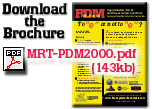12 Key Benefits
1.
How to develop a scorecard with
objective criteria to level the playing field when evaluating
Web-based
PDM systems
2.
How to define the vendor’s involvement in your implementation so
that you maximize expertise while minimizing hidden costs
3.
What kind of performance to realistically expect from Java,
HTML, and XML. What are the tradeoffs between these Web
standards?
4.
How to manage legacy data — when to integrate vs. when to
migrate
5.
Which authorization and authentication measures are best for
your organization— passwords, ID cards, electronic signatures,
user certificates
6.
How to protect security without hindering collaboration—what
goes over which firewall, and who has ultimate control
7.
How to effectively design business processes for a Web-enabled
organization
8.
How to share data across the extended enterprise with suppliers,
customers,
and non-traditional users
9.
How to stay ahead of PDM "mergers
and acquisitions mania" and develop
a contingency plan in the event your vendor is not around to
support you
10.
How to make smart investment decisions about your suite of
Web-based product development tools — and know which
technologies will converge in the near future
11.
What are the possibilities — and limitations — of the new hosted
ASP product development applications
12.
Evaluate the pros and cons of customizable systems vs.
out-of-the-box packages

|
"The focus on user based delivery vs. supplier continues to
differentiate this conference from others. It ultimately adds
more value by providing real information instead of potential
possibilities."
- Bob Christenson, Sr. Engineering Associate, Fisher Controls
[more testimonials]
Web-Based Product
Data Management:
Opportunities, Risks
and Unanswered Questions
As
the Internet enables unprecedented levels of collaboration among
product development teams and extended enterprises, the
opportunity to speed cycle time and reduce costs has never been
greater. A new generation of web-based systems and solutions is
emerging to facilitate what some call "collaborative product
commerce," or "e-Product Definition Management," and a variety
of other labels – all of which serve to confuse the community
that up until recently has been known as "PDM."
The key questions are:
- What does this new
generation of web-based systems offer that the previous
generation of PDM systems didn’t – other than the obvious
web-enablement?
- What are the
implications for users and prospective users? How do you
make sure you derive the potential benefits without falling
victim to hype and unnecessary organizational upheaval?
- When, and if, you
decide to buy a new system or to web-enable your existing
implementation, what steps should you take to protect your
data and your investment?
- How do you ensure
security over the web when sharing sensitive information
with suppliers, partners and customers?
Management Roundtable’s
conference Web-Based Product Data
Management: Opportunities, Risks and Unanswered Questions,
June 19-21, 2000 in Boston, will take a no-nonsense, hard look
at the realities behind the e-business rhetoric. You will hear
from the architects of the new systems and users of the "old"
systems alike. You will learn from some of the most advanced,
experienced (and wise) practitioners who’ve both migrated from
and integrated with legacy systems. You will be able to ask
questions in a non-sales-oriented environment and get straight
answers.
With a firm focus on users’ needs (and no rush
to change the PDM label until the industry’s identity crisis is
resolved), this conference will bring together the foremost
experts and users to help you make practical decisions that you
can implement in the near future — and use successfully for the
long run.

|

